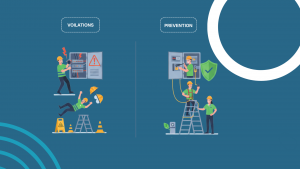In the fast-paced and technical field of HVAC (Heating, Ventilation, and Air Conditioning), safety isn’t just a priority—it’s a necessity. With daily exposure to electrical systems, refrigerants, and complex installations, HVAC technicians face a variety of potential risks. That’s where regulatory oversight plays a vital role.
The Occupational Safety and Health Administration (OSHA) has developed detailed guidelines and practices designed to protect technicians and ensure safe job sites. This blog explores how implementing these standards helps HVAC companies build safer environments and foster long-term operational success.
Why OSHA Matters in the HVAC Industry
OSHA is the federal agency responsible for ensuring worker safety and health. In the HVAC, OSHA’s requirements rules cover electrical safety, chemical handling, confined space procedures, and fall protection, among others. These standards are more than regulatory requirements—they are best practices that can save lives.
By adhering to OSHA HVAC regulations, contractors not only minimize workplace accidents but also avoid costly fines and legal consequences. Moreover, businesses that prioritize safety tend to earn greater trust from clients, employees, and partners alike.
Understanding HVAC Safety Standards
Every HVAC organization should be familiar with HVAC safety standards defined by OSHA and related industry groups. These standards encompass everything from the proper use of personal protective equipment (PPE) to labeling hazardous materials and ensuring ventilation in confined spaces.
Standards also dictate procedures for electrical lockout/tagout, ladder safety, and machine maintenance. Following these standards helps technicians perform their duties with confidence, knowing they are protected against preventable injuries.
Developing a Safety-First Culture
Safety is not a one-time initiative—it’s an ongoing culture. HVAC companies must integrate safety into every level of their operations, from fieldwork to office practices. Leadership must actively support safety programs and demonstrate a commitment to continuous improvement.
Holding regular training sessions and updating workers on new guidelines helps ensure everyone is aligned. Teams should consistently follow top safety protocols to minimize risks. Safety culture also encourages open communication, so employees feel empowered to report unsafe conditions or near-misses without fear of retaliation.
Conducting Effective Risk Assessments
Risk assessments are foundational to any safety program. Technicians should be trained to identify potential hazards before beginning work on any HVAC system. These might include faulty wiring, unstable ladders, chemical exposure, or poorly ventilated spaces.
Once risks are identified, mitigation strategies should be documented and implemented. This approach not only complies with OSHA HVAC requirements but also prevents many injuries before they happen.
Using a HVAC Safety Checklist
A HVAC safety guidelines checklist is a practical tool that guides technicians through safety protocols before starting any job. These checklists typically include items like:
- Verifying proper use of PPE
- Lockout/tagout procedures
- Tool and equipment inspection
- Ventilation confirmation
- Fire safety protocols
- Chemical handling verification
- This pre-job ritual ensures that nothing is overlooked and helps instill disciplined safety habits throughout the workforce.
Common HVAC Safety Hazards
Despite the best intentions, certain risks are inherent in HVAC work. Recognizing and addressing HVAC safety hazards is key to preventing accidents. Some of the most common include:
- Electrical shock from live wires
- Falls from ladders or roofs
- Chemical burns or inhalation from refrigerants
- Heat stress from working in extreme conditions
- Muscle strain from lifting heavy equipment
- Proper safety training, use of correct equipment, and strict adherence to OSHA guidelines can significantly reduce the likelihood of these hazards.
The Role of Training and Certification
Well-trained HVAC professionals are less likely to suffer injuries and more capable of responding to emergencies. OSHA recommends that all HVAC technicians undergo safety certification and refresher courses on a regular basis.
HVAC safety training topics should include CPR/first aid, hazardous material handling, confined space entry, electrical safety, and emergency response procedures. Many companies also provide online training modules, which allow employees to stay updated with minimal disruption to their work schedules.
SNARSCA offers comprehensive HVAC training and certification programs to help technicians meet industry standards and advance their skills
Emergency Response Planning
Despite best efforts, emergencies can still occur. Having a clear, accessible emergency response plan is critical. HVAC companies should prepare procedures for:
- Fire and electrical emergencies
- Chemical spills
- Equipment failure
- Medical incidents
- Clear signage, first aid kits, and fire extinguishers should be present at all worksites. Employees should be trained to use this equipment and understand when to call emergency services.
Final Thoughts
Implementing OSHA standards is not just about compliance—it’s about protecting lives, reducing downtime, and building a culture of responsibility. HVAC professionals are skilled tradespeople who deserve safe working environments, and employers have the legal and moral obligation to provide them.
By using tools like safety checklists, staying aware of hazards, and maintaining training programs, HVAC teams can do their best work with confidence—and without unnecessary risk.


